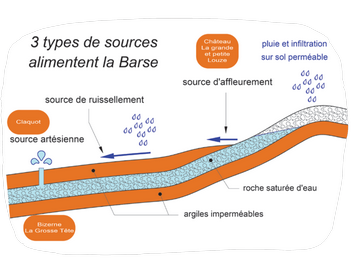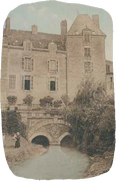Voici les différents panneaux du circuit patrimonial Mélusine :
Eau, Trésor et Origine
Water, Treasure and Origins
Do you know how many sources there are in Vendeuvre?

Sources at the root of the site
The rich soil and lush vegetation afforded by the Barse sources attracted people to the area very early on, providing them with an abundance of food. As a result, the early Gallo-Roman and Merovingian population waves settled in two main areas:
- in the vicinity of the Barse River source, spawning Vindovera;
- near another major water supply, the Claquot source, with the Vienna settlement cluster (the former Voies de Vienne district).
Over the years, people exploited the water to develop their activities.
Several mills (moulins in French) were built in close proximity to the Barse sources.
Oil was produced at the Moulin Cornet.
While the soil was processed to supply a large pottery factory at the Moulin de l’Houzotte. The water also helped to model the clay for the ‘Sainterie’ statues.
The Moulin du Prieuré (the Priory mill) located at the intersection of the Grande Rue and Avenue Leclerc, crushed grain until 1814 before becoming a paper mill. In 1837, Jean-Baptiste PROTTE purchased the mill to house his traction engine and thresher manufacturing plant which later produced the renowned Vendeuvre tractors.
The water was also used to tan hides at the lavoir des tanneries (tannery washhouse) and to power the iron-beating swifts at the Petites and Grandes Forges (Small and Large Forges).

The six key Barse sources
- Source du Château (so-called Source de la Barse)
- Source de la Grande Louze
- Source de la Petite Louze
- Source du Claquot
- Source de la Bizerne
- Source de la Grosse tête
Washhouses and mills

The different types of sources
3 types of sources supply the Barse
Claquot
Bizerne La Grosse Tête
Château La grande et petite Louze
artesian source
run-off source
outcrop source
impervious clays
water-saturated rock
rain and infiltration on porous soil

The legend of Melusine
Nicolas CHEVALIER, a notary in Vendeuvre in the 18th century, related an astonishing occurrence in his ‘Historical essay on Vandoeuvre’.
‘Renier GILLEMER, a former and elderly Templar disavowed by his brethren of the house of Troyes, a hermit residing in a clearing of the forêt d’Orient, north of Vendeuvre, in the 12th century, himself of vandal origin (a Germanic people who settled in Vendeuvre around 409 B.C.), recounts an anecdote which, while seemingly apocryphal, nonetheless merits some credit owing to its wide promotion.
According to Renier GILLEMER, the name Vandoeuvre is believed to be derived from Vandopera changed to Vandovera which is none other than the work of the Vandals. One of the very first Vandal princesses is said to have been the ruthless Melusine.
A tireless warrior, she rode the fiercest of mounts, leading her soldiers on wild expeditions, in relentless pursuit of power, domination, and devastation. Upon arriving in Vendeuvre, her troops plundered the village, slaughtered its inhabitants, and burned their houses.
On account of the many horrors that she had inflicted on the people of Vendeuvre, Melusine was turned into a fish from the waist down and forced to appear on the big tower of the Château de Vendeuvre in this dreadful state, each year, on the day of the dead (November 2nd), to beg for the end of the world through great and repeated screams.’






